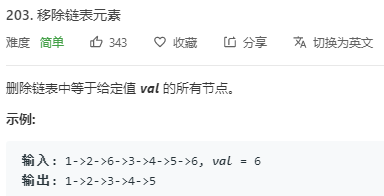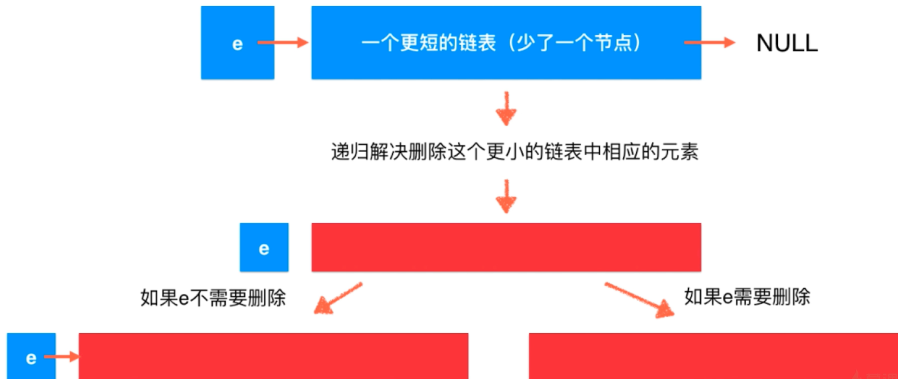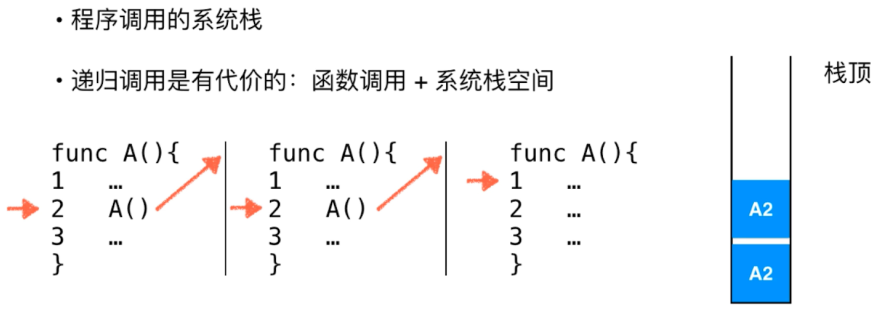玩转数据结构:第5章 链表和递归
链表和递归
5-1 Leetcode中和链表相关的问题
Java类的递归,包含的成员变量有该类本身。
ListNode

//Definition for singly-linked list. public class ListNode { public int val; public ListNode next; public ListNode(int x) { val = x; } }
/// Leetcode 203. Remove Linked List Elements
/// https://leetcode.com/problems/remove-linked-list-elements/description/

Solution

/// Leetcode 203. Remove Linked List Elements /// https://leetcode.com/problems/remove-linked-list-elements/description/ class Solution { public ListNode removeElements(ListNode head, int val) { while(head != null && head.val == val){ ListNode delNode = head; head = head.next; delNode.next = null; } if(head == null) return head; ListNode prev = head; while(prev.next != null){ if(prev.next.val == val) { ListNode delNode = prev.next; prev.next = delNode.next; delNode.next = null; } else prev = prev.next; } return head; } }
Solution2

/// Leetcode 203. Remove Linked List Elements /// https://leetcode.com/problems/remove-linked-list-elements/description/ class Solution2 { public ListNode removeElements(ListNode head, int val) { while(head != null && head.val == val) head = head.next; if(head == null) return head; ListNode prev = head; while(prev.next != null){ if(prev.next.val == val) prev.next = prev.next.next; else prev = prev.next; } return head; } }
Solution3

/// Leetcode 203. Remove Linked List Elements /// https://leetcode.com/problems/remove-linked-list-elements/description/ class Solution3 { public ListNode removeElements(ListNode head, int val) { ListNode dummyHead = new ListNode(-1); dummyHead.next = head; ListNode prev = dummyHead; while(prev.next != null){ if(prev.next.val == val) prev.next = prev.next.next; else prev = prev.next; } return dummyHead.next; } }
5-2 测试自己的Leetcode链表代码

//Definition for singly-linked list. public class ListNode { public int val; public ListNode next; public ListNode(int x) { val = x; } // 链表节点的构造函数 // 使用arr为参数,创建一个链表,当前的ListNode为链表头结点 public ListNode(int[] arr){ if(arr == null || arr.length == 0) throw new IllegalArgumentException("arr can not be empty"); this.val = arr[0]; ListNode cur = this; for(int i = 1 ; i < arr.length ; i ++){ cur.next = new ListNode(arr[i]); cur = cur.next; } } // 以当前节点为头结点的链表信息字符串 @Override public String toString(){ StringBuilder s = new StringBuilder(); ListNode cur = this; while(cur != null){ s.append(cur.val + "->"); cur = cur.next; } s.append("NULL"); return s.toString(); } }
class Solution3

class Solution3 { public ListNode removeElements(ListNode head, int val) { ListNode dummyHead = new ListNode(-1); dummyHead.next = head; ListNode prev = dummyHead; while(prev.next != null){ if(prev.next.val == val) prev.next = prev.next.next; else prev = prev.next; } return dummyHead.next; } public static void main(String[] args) { int[] nums = {1, 2, 6, 3, 4, 5, 6}; ListNode head = new ListNode(nums); System.out.println(head); ListNode res = (new Solution3()).removeElements(head, 6); System.out.println(res); } }
5-3 递归基础与递归的宏观语意
本质上,将原来的问题,转化为更小的同一问题。
递归函数就是一个函数,完成一个功能。


public class Sum { public static int sum(int[] arr){ return sum(arr, 0); } // 计算arr[l...n)这个区间内所有数字的和 private static int sum(int[] arr, int l){ if(l == arr.length) return 0; return arr[l] + sum(arr, l + 1); } public static void main(String[] args) { int[] nums = {1, 2, 3, 4, 5, 6, 7, 8}; System.out.println(sum(nums)); } }
5-4 链表的天然递归结构性质


class Solution4 { public ListNode removeElements(ListNode head, int val) { if(head == null) return head; ListNode res = removeElements(head.next, val); if(head.val == val) return res; else{ head.next = res; return head; } } public static void main(String[] args) { int[] nums = {1, 2, 6, 3, 4, 5, 6}; ListNode head = new ListNode(nums); System.out.println(head); ListNode res = (new Solution4()).removeElements(head, 6); System.out.println(res); } }
5-5 递归运行的机制:递归的微观解读

部分内容来自于学习编程期间收集于网络的免费分享资源和工作后购买的付费内容。
如需获取教程配套的资源文件和一对一专属答疑支持,请加vx:kangmf24联系作者。




